Mono, stereo, surround - since the second half of the 20th century the world has been on quite the journey through sound.
But it’s never been quite so intensely captivating as spatial sound - a truly immersive and 3D experience which puts the listener in an audio environment that feels like escapism.
Listen to an audiobook created with spatial sound and it can feel like you’re walking in the shoes of the main character, without ever opening your eyes - a remarkably lifelike sonic experience that’s levels above surround sound at the cinema.
It’s literally changing how we listen - and in Plymouth, two masters of sound are at the forefront of the development of this immersive experience.
Matthew Raistrick is one half of Exitus Ab - roughly Latin for escaping from reality - a spatial sound production company doing pioneering work which is earning global recognition.
He and his business partner, Ryan Thorne, both completed a Master’s in 2020, specialising in innovation in sound. Next, they set up Exitus Ab - a “hands-on, innovation-driven production house, creating bespoke spatial sound design and music for audiobooks, TV, film, games and advertising”.
They were one of the companies on show at this year’s Fulldome Festival, a global celebration of immersive technology - hosted by ‘fulldomes’ across the world including the new Immersive Dome at the Market Hall in Devonport.
“We’ve been looking at taking the concept of audio books and making them into full 3D, spatial experiences where we’re able to put the listener in the shoes of a main character in a narrative,” explains Matthew.
“The whole world is just imagined around you, formatted in a binary format, so it’s headphone-based, but it’s very intimate because of that.
“As much as we love film media, and we’ve spent a lot of time in the industry, we find that visuals are always at the forefront and sound becomes secondary and it’s always dubbed over in post-production.
“In our company we wanted to be sound specialists where sound is the primary catalyst and the driving force of a production, and it’s still something that’s quite unique and new in the industry.”
It’s a difficult concept to wrap your ears around but a quick taster of one of Exitus Ab’s audiobooks (try their YouTube, Soundcloud and socials) and the experience is breathtaking.
The duo became involved with Real Ideas, creators of Market Hall and the Dome, earlier this year, and are in no doubt of the power the Immersive Dome could have in making Plymouth a capital for immersive experiences while giving a platform to innovative new businesses such as Exitus Ab.
“It’s something that’s incredibly unique for Plymouth. Opportunities-wise it’s provided us with not quite a residency, but at the moment we’re freelanced in and we’re able to offer support for the system here. We’ve got a 19.1 system which is incredibly modular.
“Just yesterday we had the first live performance that they’ve had here in situ, which ended up being a really incredible and completely unique experience. We’re able to develop our craft, really get to know this space. And we’re looking to put on our own content that’s going to be provisioned here as well in the future.”
Matthew is aware of how spatial sound is slowly making waves around the world. The recent introduction of Apple’s Spatial Sound integration has brought it mainstream and Plymouth could play a vital role in its development - attracting investment and helping build careers.
He said: “Spatial sound in terms of creative media in the South West at the moment is very low level. And in the wider industry, Apple has just introduced its spatial sound integration.
“But having this opportunity to be able to work with local schools, putting workshops on and doing induction and training sessions on the audio system here means we can engage with the local community and really then inspire the new generation of content creators who are going to be putting art projects on in this space.”
This activity is part of the iMayflower project and has been supported by The Department for Digital, Culture, Media and Sport, who fund the Cultural Development Fund, which is administered by Arts Council England. iMayflower is led by Plymouth City Council and delivered in partnership with Creative England, Crowdfunder, Destination Plymouth, Plymouth College of Art, the Real Ideas Organisation and University of Plymouth.
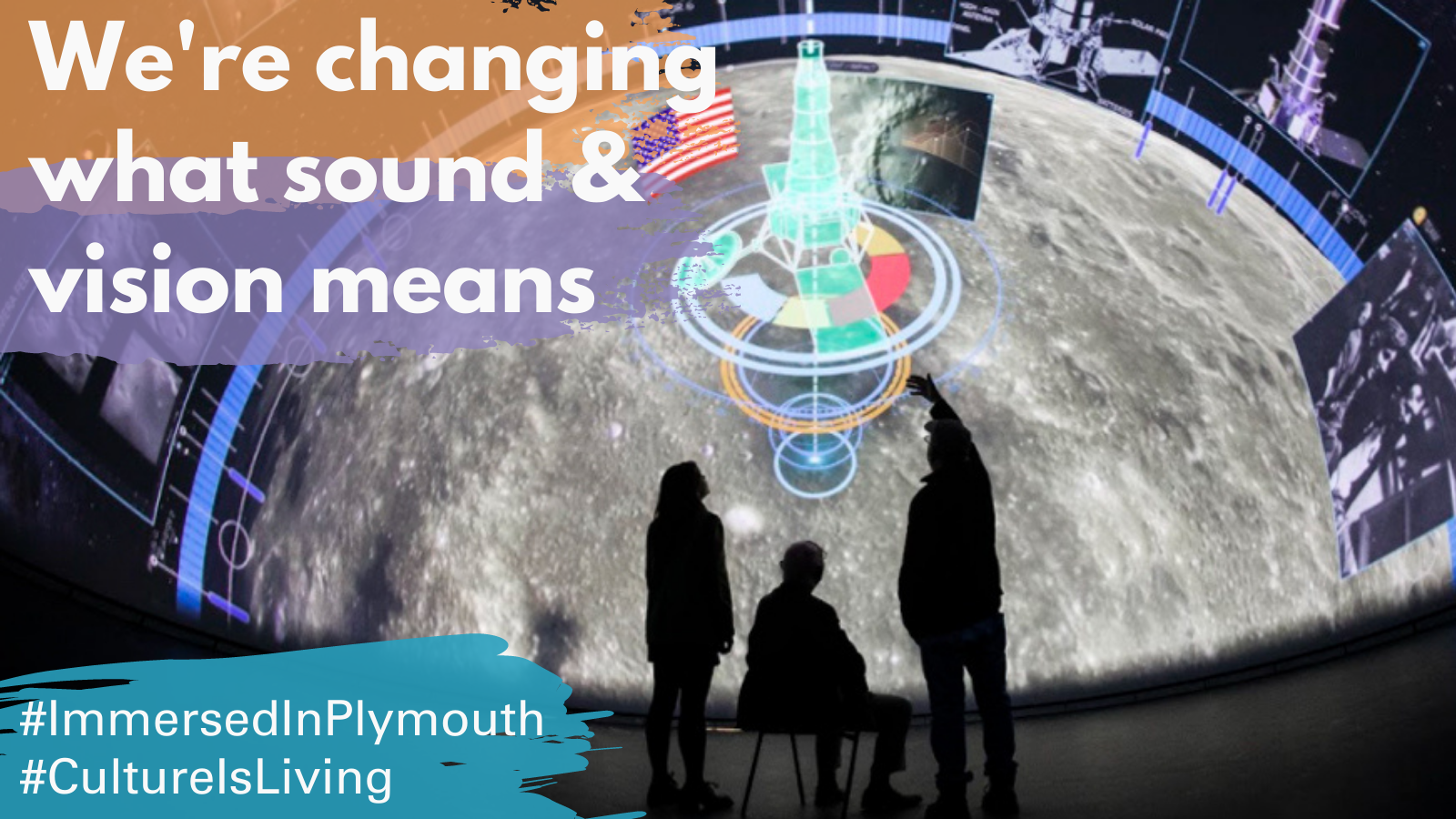
Wrapping around you through 180 degrees, images beamed at all angles, senses transfixed by a very different type of storytelling - it’s easy to feel your jaw drop when you stand in the centre of the Immersive Dome.
Found in Plymouth’s newly refurbished and re-imagined Market Hall development, you’re unlikely to have ever experienced anything quite like it outside of wearing a virtual reality (VR) headset.
The first of its kind in Europe and one of only a handful of its kind around the world, it’s a quite remarkable space that makes a statement of Plymouth’s digital and creative capabilities.
For this is no pet project or flashy show of digital strength. While the gigantic Immersive Dome’s seamless shared virtual reality experience is truly unique cutting edge both in picture and in sound, it’s part of a wider network of immersive creativity that has become woven around the city.
This network has helped Plymouth lay a marker on immersive. Britain’s Ocean City is making virtual waves and becoming known as a leader in a niche that has come to dominate the future of creative technologies.
Virtual and augmented reality (AR) has long captured public imagination. But until now the practicalities of it have always felt out of reach, an experience where the technology hadn’t quite kept up with our expectations.
That is rapidly changing. Immersive experiences are no longer just for those who can afford perversely expensive headsets. Now, immersive is infiltrating daily life - and in multiple sectors.
VR and AR are not exclusively for home entertainment. Aerospace engineers use it to help wire aircraft. VR is used to help paraplegics regain control of their lower limbs. Theme parks use it to add another layer to roller coasters. KFC has even used it to train employees to fry chicken.
In Plymouth, the infrastructure has been slowly but surely put in place to enable the city to lead on the development of immersive experiences that slowly enter increasing aspects of how we lead our lives.
The Market Hall itself was created in collaboration by owners Real Ideas, Plymouth City Council and the University of Plymouth. The Immersive Dome’s forerunner, the William Day Planetarium (now the Immersive Vision Theatre), was for decades largely hidden from public view.
Today, the University offers a degree course in Virtual Reality Design, where students learn to design immersive media and create content that will influence communication, work and play in the future.
Its Immersive Media Laboratory provides facilities for 3D scanning and motion capture as well as space to experiment with AR and VR technologies. There’s an open invitation to use it to test new games, products, immersive experiences, educational innovations and medical simulations.
Across the road, Plymouth College of Art creates immersive experiences that redefine our expectations of how we learn about the world around us and our perception of what culture is. They work with designers and artists to create experiences that respond to the key issues of our time, communicating in powerful new ways.
This network of organisations is woven far further but demonstrates the level of collaboration now very much energised, attracting key talent to Plymouth and building a powerful reputation for immersive excellence.
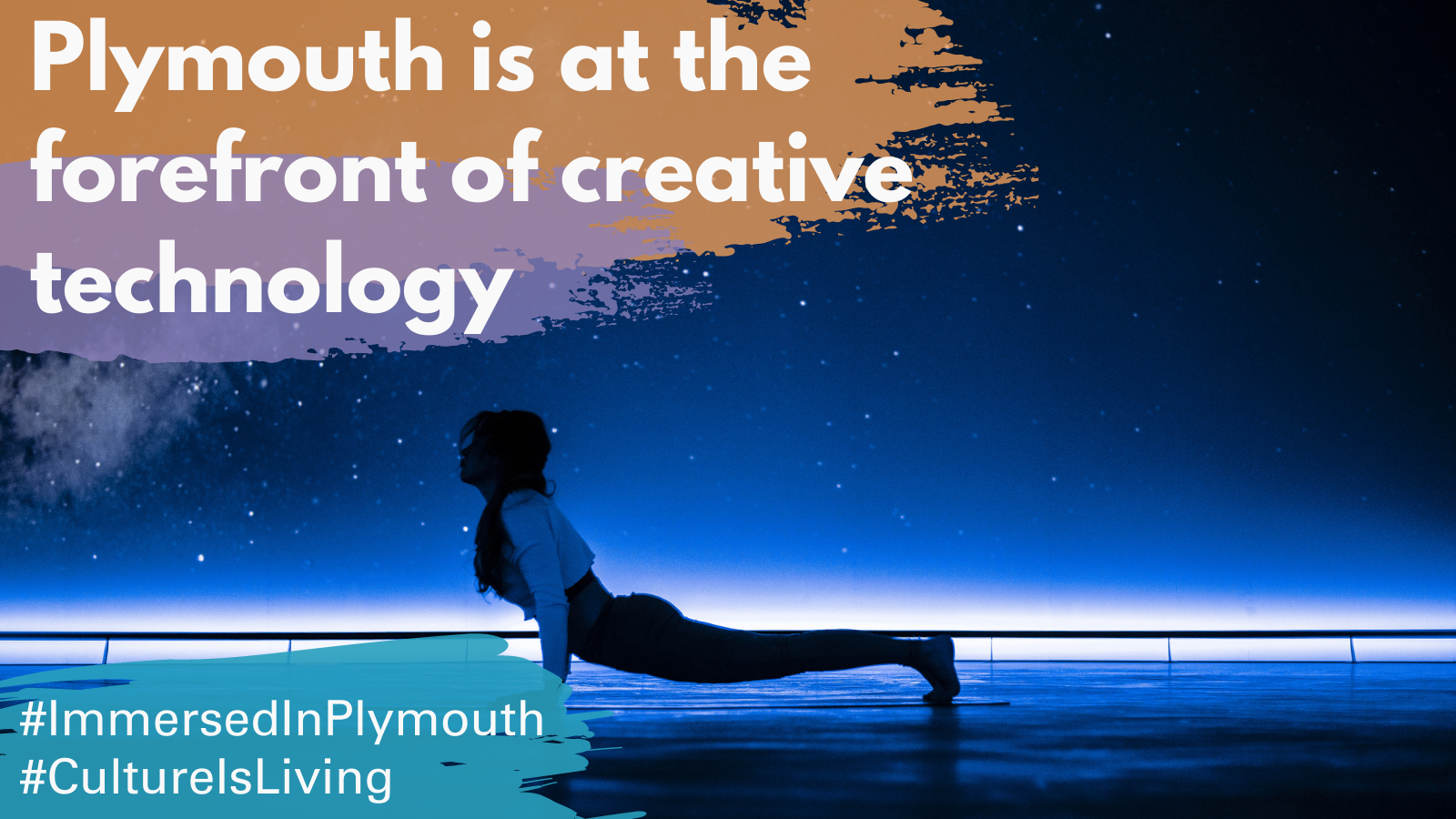
In a city surrounded by immersive experiences - the ocean, the moors, the cityscape - these state-of-the-art spaces and collaborations are emerging at its heart that can genuinely change the way we live our lives.
The Market Hall, a historic building nestled in the heart of Devonport, is positioned at the bridge between Plymouth’s emerging tech cluster and industries more closely associated with its heritage as a seafaring, working-class city.
Just a walk away is Oceansgate, a hub of world-class marine organisations who collaborate, research, develop and produce beside Plymouth’s famed waters.
Clusters like Oceansgate, or neighbours Babcock - the international naval, aerospace and security company - are using immersive technology in increasingly innovative ways - in their engineering, in manufacturing, in defense.
The type of immersive content for which creators make use of the Dome is not just being made for audiences in an entertainment environment.
It’s being used over the wall at the dockyard. It’s transforming the health sector, where immersive technologies are used to train students and medical practitioners before exposing them to real-life patients through interactive learning. It’s making waves in the tourism sector, where emotionally impactful virtual experiences are transforming what it means to travel.
Career opportunities for young people in Plymouth that might start with a mind-blowing VR experience are becoming a reality, and not literally a virtual one. Opportunities in immersive can lead to careers that are redefining industries.
Plymouth has the infrastructure, the talent and the partners. It has the skill sets to be a leader in immersive, to be a magnet for attracting people and investment - and to be a UK leader in an industry-revolutionising digital and creative world.
This activity is part of the iMayflower project and has been supported by The Department for Digital, Culture, Media and Sport, who fund the Cultural Development Fund, which is administered by Arts Council England. iMayflower is led by Plymouth City Council and delivered in partnership with Creative England, Crowdfunder, Destination Plymouth, Plymouth College of Art, the Real Ideas Organisation and University of Plymouth.
Matt found his way to design through an unconventional route, initially signing up for a degree in Astrophysics straight after completing his A-Levels. Soon realising that this wasn’t the right pathway for him, Matt returned to the classroom as a science technician, preparing lessons for students. In his spare time, however, Matt was an avid maker.
“I have always enjoyed tinkering,” Matt said. “I was always being ‘handy’, either making signs or furniture. There’s something to be said for looking at what you enjoy doing for fun and developing that interest into a career.”
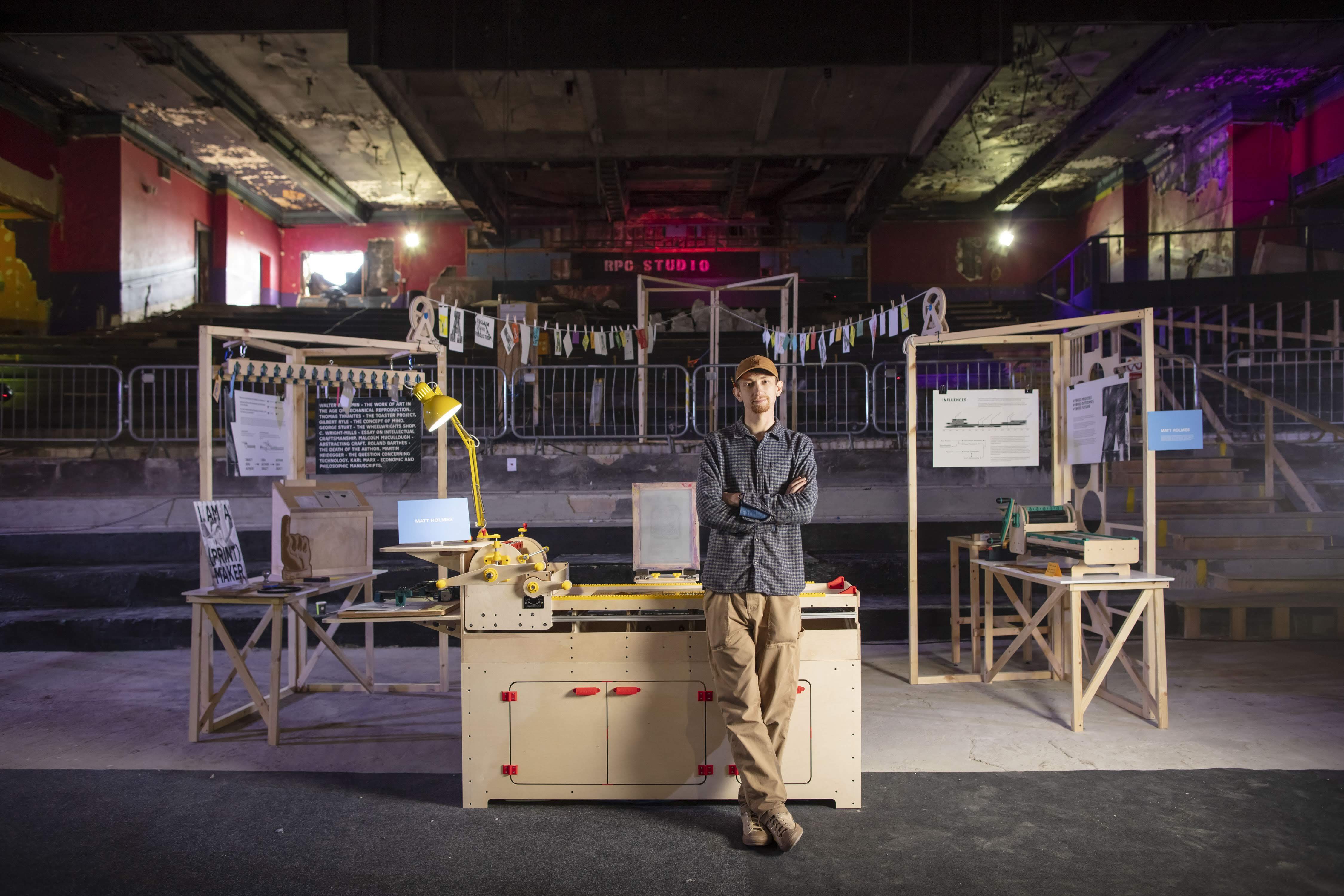
Matt in the Millennium Building, Photo Courtesy of Lloyd Russell, University of Plymouth.
Changing the direction of his career was not a decision that Matt took lightly: “The decision to return to education as a mature student was a big one. I moved across the country from Essex to Devon, which was quite scary. But as a mature student I had a different work ethic to a lot of my peers, and tended to engage with my work quite intensely. Being surrounded by people younger than me taught me that I didn’t have to work quite so manically. In turn, I like to think I taught some of the other students in my group some useful things, like the inevitability of deadlines!”
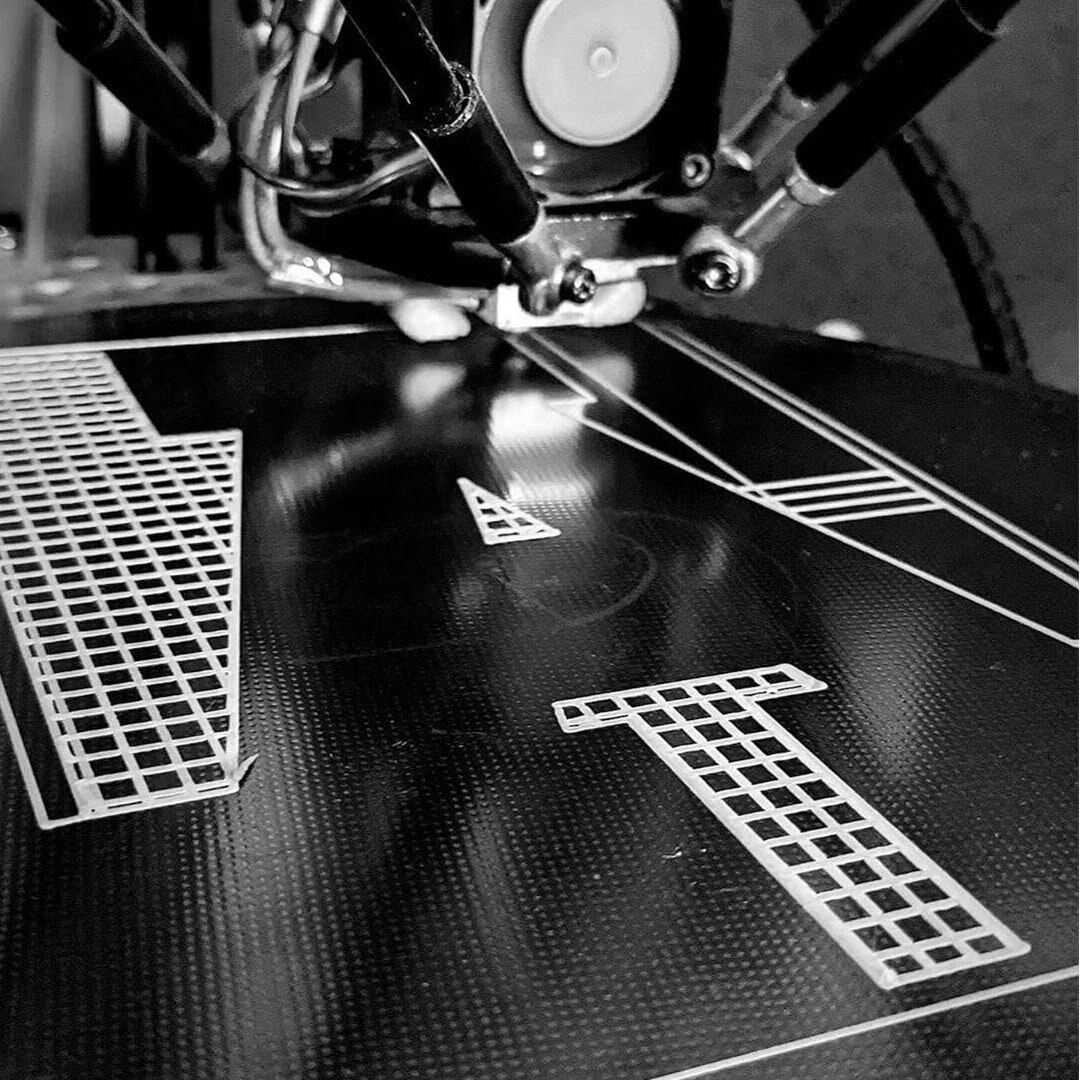
As a lover of big chunky type, Matt is inspired by the work of designers such as Anthony Burrill.
Matt initially thought that his career would lead him towards furniture making. His talents saw him gain a place at The Snowdon Summer School, to learn furniture making from master craftsmen. Surrounded by Chippendale tables and cabinets, Matt saw other students produce pieces using marquetry (the art of applying pieces of veneer to form designs) in traditional patterns, where he interpreted the brief in a different way: “My design was inspired by looking at the carpet and noticing the pattern didn’t quite match up!”.
This appreciation of imperfections became a theme that led Matt’s work towards typography. The discovery of a damaged, forgotten typeface in a workshop led him to consider how he might restore it. “I recognised that the marks and imperfections told a story”, Matt said. His use of modern technologies like 3D-printing, together with legacy techniques, led to a fascination with democratising heritage processes such as letterpress and typesetting.
Matt was in the middle of developing his letterpress equipment when the COVID-19 pandemic first hit, during his BA. “I realised pretty quickly that I wouldn’t have access to all these tools in the workshop, that channelled me into using the tools I had at home, like a simple jigsaw. It forced me to consider the tools other people had around them. I realised how inaccessible these heritage techniques were to others. Without use they die out. It made me ask myself how can I make them accessible to a wider audience?”
The culmination of this work saw Matt successfully create his own letterpress printing press, including the instructions to build it, distilled into an email. “Theoretically I can send this to anyone, anywhere in the world and they will be able to build it. It makes it available to all”. One of the first people Matt sent it to was printmaker Anthony Burrill. “I have always admired his work and to have him respond to me was such a fantastic boost, I couldn’t believe I was having a Zoom conversation with him whilst sat in my shed!”
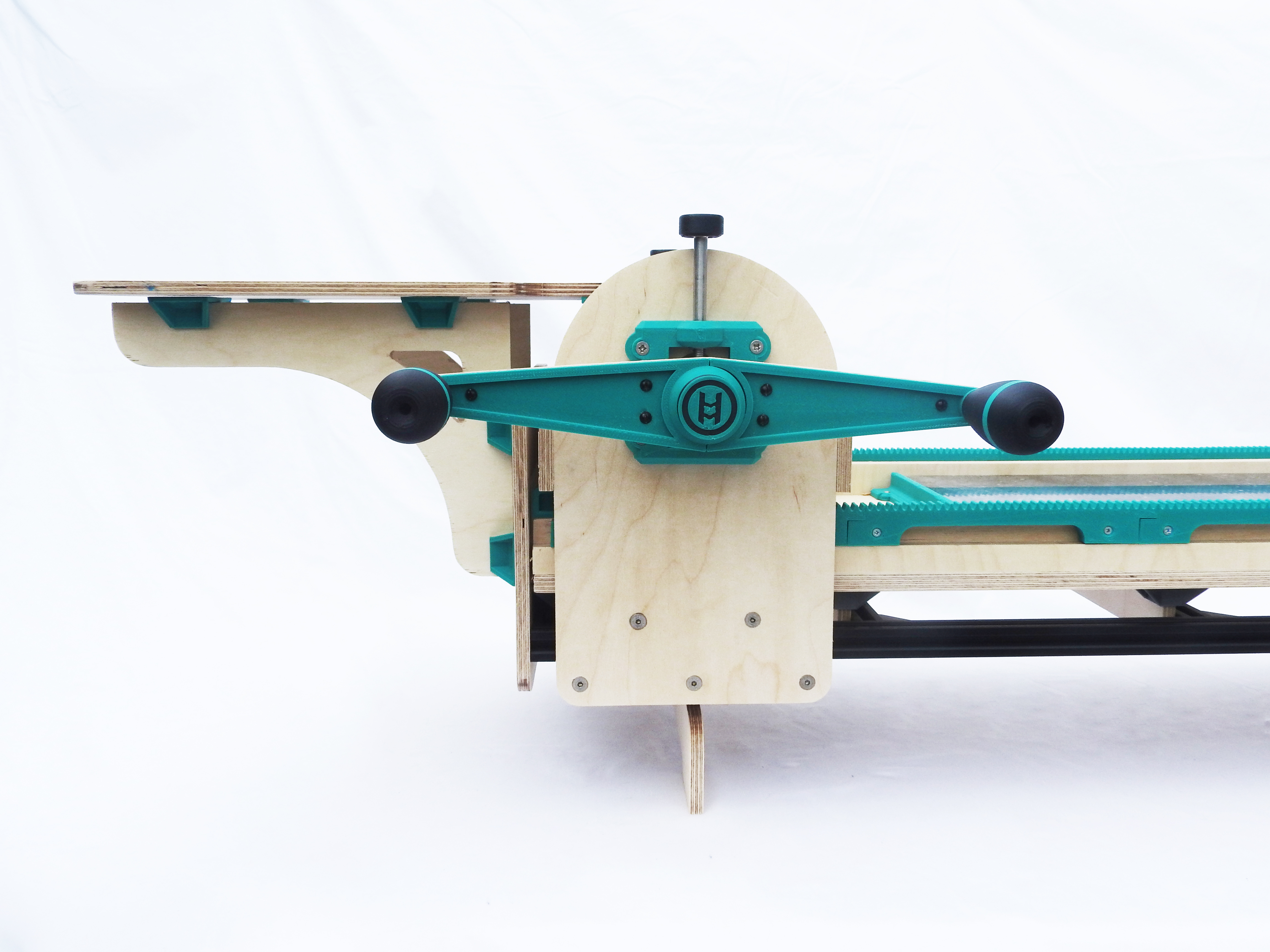
Matt's 3D printed and plywood printing press.
“Heritage is a concept, quite different from History,” Matt said, “which I believe can risk a craft getting locked in, with people saying ‘it’s the way things are done’, which can become a form of gatekeeping. What carpenter would lament the invention of the electric drill? I don’t feel that new technologies change the skill. After all, a potter throwing on an electric wheel is still creating with their hands. I engage with my letter press as I pull the print by hand - and that physicality keeps the magic of the craft in there.”
Matt brings this ethos of democratisation into his work in Fab Lab Plymouth. “I recognise that the Fab Lab space can be intimidating to enter”, Matt admits. “It has big machines that look dangerous and if you’ve never worked in this space before, it’s easy to think that it might not be for you. The reality, however, is that this space is for everyone. I haven’t been working here long, but already we’ve supported BA (Hons) Illustration students to explore how they can use the laser cutter to make tools to work in the printmaking space. There is lots to learn through cross-pollination between disciplines. Come down and discover what you can do! There is so much that computers make possible that you can’t do alone by hand. My favourite slogan for the Fab Lab is ‘We are part of a bigger process’ and I truly believe that.”
In Matt’s personal practice, he continues to add to and modify his letterpress. For Matt, the letterpress has become symbolic of his creative journey, as a designer, a maker and a printmaker. As a Technical Demonstrator in Fab Lab, he’s on hand to help students with their own creative journeys.